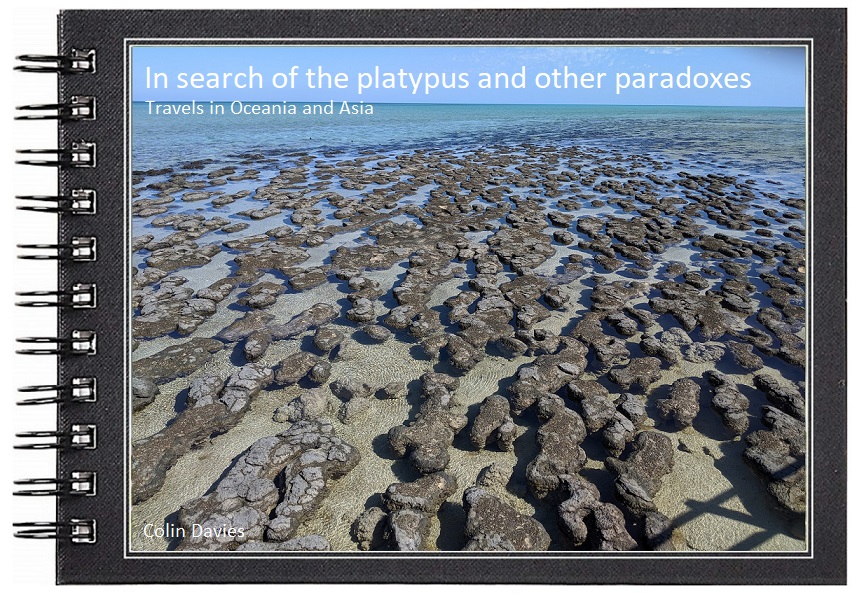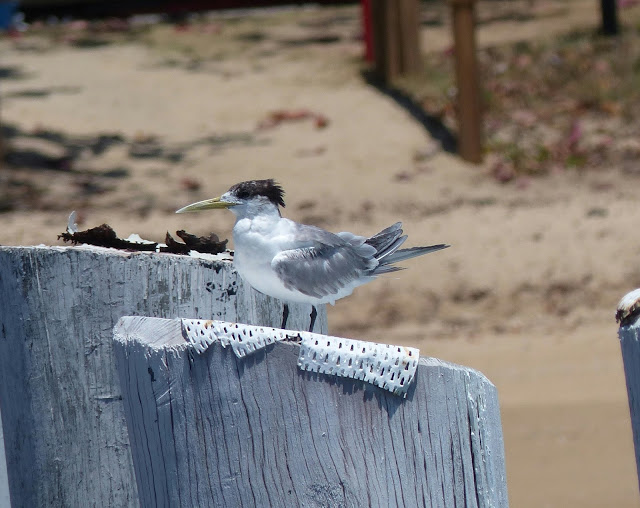On 11th October 2015 we arrived in Sydney at the start of a 3 week holiday to Australia, my first ever visit to country, in fact my first visit to the southern hemisphere. It wasn't purely a birding holiday, it was as much about general sightseeing, and the first seven days were to be spent in or around Sydney. We did the usual, went to the Opera House, walked across the bridge, went to the Rocks, sunbathed on Bondi beach, did some shopping etc., but we also spent time in the Botanical Gardens and took the ferries to Watsons Bay and Manly, and ventured off the main tourist route a little when we visited Centennial Park on a couple of occasions and took the coastal footpath from Bondi beach to Coogee, and even spent half day whale watching. So plenty of opportunities to see lots of Australian wildlife and in fact it proved to be a nice gentle way of starting the holiday from a birding point of view.
Sunday, 8 November 2015
Saturday, 7 November 2015
Full list of birds seen in Australia - 2015 holiday
This is a full list in alphabetical order of species seen on the holiday, 12th -31st October 2015, with location and maximum number of birds seen at each location in brackets.In total, 170 species of which 144 were new for me.
Mudskippers
During the holiday we saw what looked like two different species of mudskipper at Port Douglas. The first was a small fish about 3" (7.5cm) long and which inhabited the mud on the edge of the marina. This was a very limited habitat, with mud no more than about 1m wide, with rocks and scattered mangroves growing in it. From memory I don't remember this habitat expanding or contracting much with the tide, i.e. there wasn't much of a tidal range.
The second type of mudskipper was seen on the banks of the tidal section of river at Port Douglas. Here on the edge of the mangroves there was much more exposed mud and the mudskippers here were a lot bigger, some reaching 8" (20cm). There were also no rocks on this mud and it seemed to have a large tidal range.
When I saw them I couldn't be sure if these were the same species as those seen in the harbour, i.e. I thought it possible that the larger fish were simply the adults whilst the smaller fish might be juveniles occupying a different habitat.
Since I've been back in the UK I've been doing some research to try to find the truth about these fascinating creatures. Whilst searching the internet for infromation I came across a paper called "The natural history of mudskippers in northern Australia, with field identification characters - Takita, Larson & Ishimatsu (2011)". It cost me £2 to download but proved to be an excellent read.
It turns out that not only are there many species of mudskipper in northern Australia, there are in fact several genera. I'm now convinced that we saw two species, in fact I think that they are from two different genera Periophthalmodon and Periophthalmus. They're a bit difficult to id for sure from photographs, but I think that the large fish from the river is Periophthalmodon freycineti or giant mudskipper whilst the fish from the harbour is silver-lined (barred) mudskipper Periophthalmus argentilineatus.
Giant mudskipper.
Silver-lined mudskipper. I think.... I can't see the silver lines on this one but it was in the same area as the fish above.
The second type of mudskipper was seen on the banks of the tidal section of river at Port Douglas. Here on the edge of the mangroves there was much more exposed mud and the mudskippers here were a lot bigger, some reaching 8" (20cm). There were also no rocks on this mud and it seemed to have a large tidal range.
When I saw them I couldn't be sure if these were the same species as those seen in the harbour, i.e. I thought it possible that the larger fish were simply the adults whilst the smaller fish might be juveniles occupying a different habitat.
Since I've been back in the UK I've been doing some research to try to find the truth about these fascinating creatures. Whilst searching the internet for infromation I came across a paper called "The natural history of mudskippers in northern Australia, with field identification characters - Takita, Larson & Ishimatsu (2011)". It cost me £2 to download but proved to be an excellent read.
It turns out that not only are there many species of mudskipper in northern Australia, there are in fact several genera. I'm now convinced that we saw two species, in fact I think that they are from two different genera Periophthalmodon and Periophthalmus. They're a bit difficult to id for sure from photographs, but I think that the large fish from the river is Periophthalmodon freycineti or giant mudskipper whilst the fish from the harbour is silver-lined (barred) mudskipper Periophthalmus argentilineatus.
Giant mudskipper.
Silver-lined mudskipper. I think.... I can't see the silver lines on this one but it was in the same area as the fish above.
Whimbrel N. p. variegatus
Just a quick note on the whimbrel I saw at Port Douglas, turns out they were of the Asian race N. p. variegatus which is intermdiate between the Eurasian and Hudsonian whimbrels, in that it has a whitish rump barred brown.
Saturday, 31 October 2015
Friday, 30 October 2015
Watsons Bay, Sydney.
Back in Sydney and spent the day at Watson Bay. Nothing new but some nice views of some old favourites.
Noisy miner at nest.
New Holland Honeyeater.
Crested pigeon.
Superb fairywren.
Noisy miner at nest.
New Holland Honeyeater.
Crested pigeon.
Superb fairywren.
Thursday, 29 October 2015
More from the Blue Mountains
A few new birds added to the holiday list today, some of which I managed to get photos of.
Crimson rossella.
Galah
Golden whistler.
Fan-tailed cuckoo.
Bell miner.
Crescent honeyeater.
Red-whiskered bulbul.
I think this is a female satin bowerbird but if anybody knows different let me know.
Crimson rossella.
Galah
Golden whistler.
Fan-tailed cuckoo.
Bell miner.
Crescent honeyeater.
Red-whiskered bulbul.
I think this is a female satin bowerbird but if anybody knows different let me know.
Wednesday, 28 October 2015
Katoomba, Blue Mountains
We're in the Blue Mountains at Katoomba for the rest of the week and today had a walk to the Three Sisters. It's a little bit touristy but still a decent walk and fairly quiet away from the most popular bits. Birding was quite tough going and bird photography almost impossible but I picked up a few new birds including the spectacular eastern spinebill, crimson rossella, black-faced cuckoo-shrike and white-throated treecreeper. The hot humid weather of Port Douglas is now a distant memory, temperatures here peaked at about 17'C today!
There are loads of ferns in these woodlands, I particularly like these tree ferns. Very prehistoric looking. Not a lot of flowers though and that's been a feature of the whole holiday, very few flowers either in temperate or tropical rain forest, or anywhere else for that matter, except in people's gardens.
Pathetic. The best I could manage of the wonderful eastern spinebill. Better luck tomorrow I hope.
There are loads of ferns in these woodlands, I particularly like these tree ferns. Very prehistoric looking. Not a lot of flowers though and that's been a feature of the whole holiday, very few flowers either in temperate or tropical rain forest, or anywhere else for that matter, except in people's gardens.
Pathetic. The best I could manage of the wonderful eastern spinebill. Better luck tomorrow I hope.
Tuesday, 27 October 2015
Crested Tern, Palm Cove
On our way to Cairns airport for our flight to Sydney, but called in at Palm Cove and had excellent views of a crested tern. This is a pretty common species all around the coast of Australia.
Also at Palm Cove we had nice views of this varied honeyeater.
Also at Palm Cove we had nice views of this varied honeyeater.
Monday, 26 October 2015
Spring low tide on Four Mile Beach
I spent the low tide this afternoon on the southern end of Four Mile Beach, just at the point where the mangroves begin. It's a great spot for waders, many times better than the dull Cairns esplanade. Today I saw about 20 red-necked stints, 3 beach thick-knees, Terek sandpiper, 30 red-capped plovers, 10 Pacific golden plover, greater and lesser sand plovers, whimbrels, and best of all a far eastern curlew. Also osprey, whistling kite and great egret.
Just like buses.... I tried so many times in this very spot and failed, yet today there were three on the beach!
Black-necked stork, not on Four Mile Beach.
Spring tides of course bring not only the highest tides of the year, but also the lowest, and at such times parts of the beach are revealed which would otherwise be under water. Right by the waters edge today I found lots of these honeycombed coral like formations, and then a few of the branched structures below. They were all hard and looked like coral, which is probably what they are. It was a little nerve wracking walking through the rock pools since we are now only a week or two away from box jellyfish season, and that's a marine animal I was not keen to encounter!
This pufferfish was splashing around in the shallows and was able to propel itself quite well if approached too close, despite the lack of water and didn't seem too bothered if it ended up almost out of the water. I don't know anything about fish, but this looks like Manila or narrow-lined pufferfish (Arothron manilensis) to me.
Just like buses.... I tried so many times in this very spot and failed, yet today there were three on the beach!
Black-necked stork, not on Four Mile Beach.
Spring tides of course bring not only the highest tides of the year, but also the lowest, and at such times parts of the beach are revealed which would otherwise be under water. Right by the waters edge today I found lots of these honeycombed coral like formations, and then a few of the branched structures below. They were all hard and looked like coral, which is probably what they are. It was a little nerve wracking walking through the rock pools since we are now only a week or two away from box jellyfish season, and that's a marine animal I was not keen to encounter!
This pufferfish was splashing around in the shallows and was able to propel itself quite well if approached too close, despite the lack of water and didn't seem too bothered if it ended up almost out of the water. I don't know anything about fish, but this looks like Manila or narrow-lined pufferfish (Arothron manilensis) to me.
Salt water crocodiles, Port Douglas
We spent the morning watching crocodiles and mudskippers at Port Douglas from on board the Lady Douglas
Croc versus great egret. I know which my money is on!
The mudskippers we saw today were much larger than those seen previously, this specimen for example is a good 8" long.
Croc versus great egret. I know which my money is on!
The mudskippers we saw today were much larger than those seen previously, this specimen for example is a good 8" long.
Subscribe to:
Comments (Atom)
-
Photo: Snowy albatross. "Wanderer at 6 o'clock!", the cry went up and sent shivers down my spine. This was the moment I ha...
-
I've been to Southern India twice now, but neither were birding holidays. The first was to meet the family of my son's...
-
Philips Island is a 90 minute drive south east of Melbourne. It's a proper island but you can drive onto it via a bridge. The day we ...























































